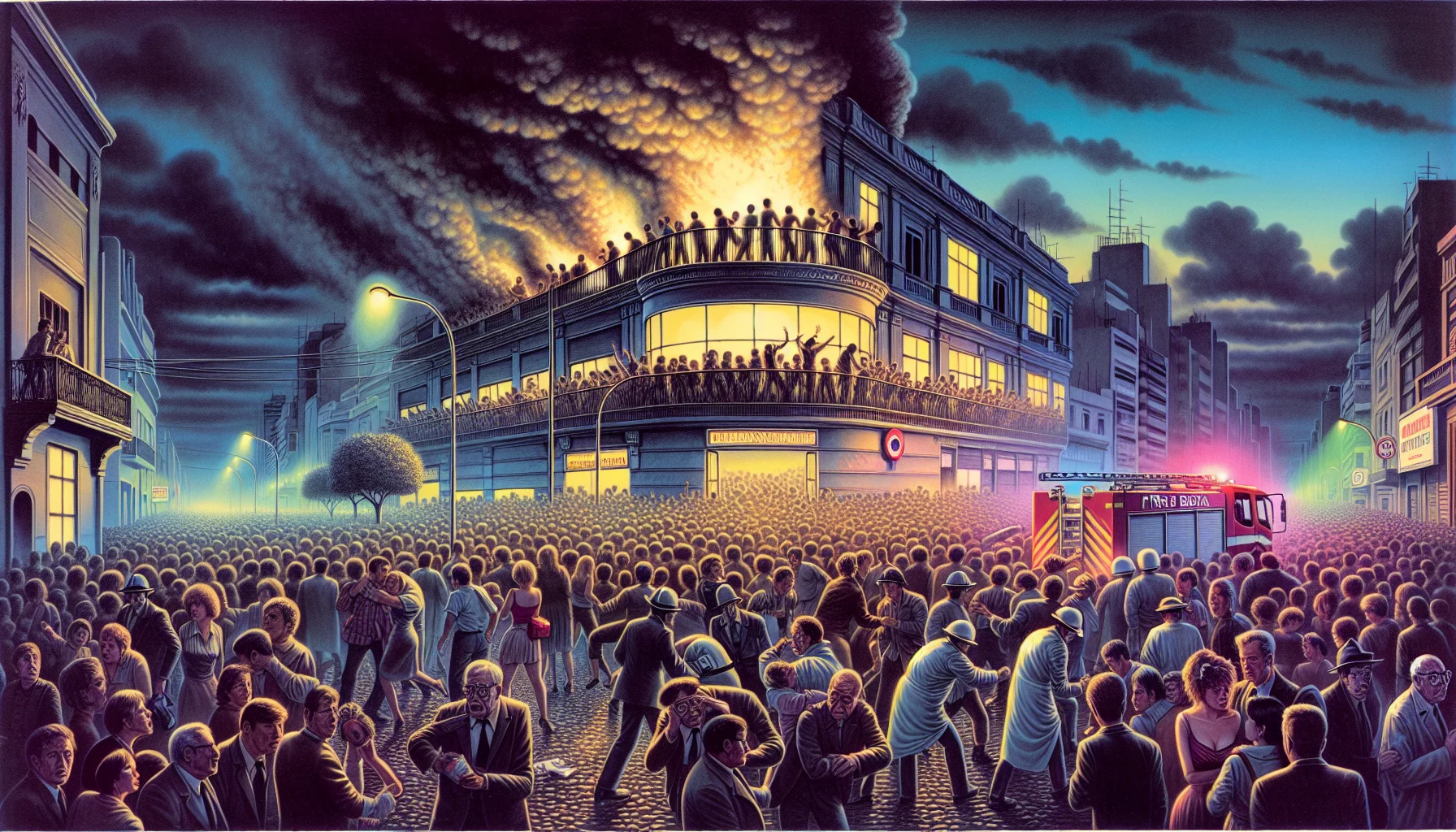
Cromañón Nightclub Fire
by: The Calamity Calendar Team
December 30, 2004
A Night of Anticipation
On December 30, 2004, the air in Buenos Aires was electric with anticipation. Young music lovers flocked to the Once district, drawn by the promise of an exhilarating concert by the renowned rock band Callejeros. República Cromañón, the venue for the night, was a popular haunt for many, known for its vibrant music scene. As concertgoers streamed into the club, excitement overshadowed the sobering reality of overcrowding. Though the club had a capacity for 1,000, estimates suggest over 3,000 eager fans squeezed into the building that fateful night.
The attendees, mostly adolescents and young adults, had little knowledge of the looming danger. The club's ownership had not prioritized safety, a fact tragically belied by chained emergency exits intended to curb free entry. This seemingly mundane decision would soon prove catastrophic. As the crowd reveled in the music and energy, a hidden peril lay overhead—the ceiling lined with combustible materials unsafe for such events.
Ignition and Chaos
Near 10:50 PM, amidst the thumping melodies and pulsating lights, a cultural flourish proved fateful. A flare or pyrotechnic device, ignited by an enthusiastic fan, lifted spirits for mere seconds before it set its destructive course. The spirited gesture turned quickly into chaos as the flare ignited the club's ceiling. Flames spread with alarming speed, consuming the room's interior almost insidiously before bursting into a full blaze.
In moments, what began as thrilling energy converted into palpable panic. The cheerful atmosphere turned tense as thick, acrid smoke filled the venue, obstructing vision and breathing. The fire's growth was merciless, and soon, so was the movement of the crowd. Panic-stricken attendees surged toward exits, only to be met with an unimaginable horror. The barricaded emergency exits offered no escape, effectively trapping many inside.
A Nightmarish Struggle
What transpired within those walls over the next few minutes was both terrifying and heart-wrenching. As flames engulfed the room, people struggled desperately to find any means of escape. Smoke inhalation proved the deadliest foe, claiming lives and complicating the escape efforts. Amidst the confusion, there were instances of commendable bravery, with individuals attempting to save others even as their own lives were in peril.
Firefighters and emergency responders arrived swiftly, yet the scale of the disaster was staggering. With the building engulfed in flames and people struggling to break free, the rescuers faced immense challenges in navigating the site. The calamity inside mirrored the chaos outside as loved ones, drawn by distress calls, gathered hoping for a glimpse of friends and relatives.
Thanks for subscribing!
Devastating Toll and Community Grief
The post-midnight hours laid bare the catastrophe's full extent. The fire claimed 194 lives, casting a shadow of grief over Buenos Aires and resonating across Argentina. The tragedy's fallout was not confined to those who perished. Thousands sustained injuries—both physical and psychological—inflicted by the flames or the sheer panic.
As the news spread, the nation, awash with grief, demanded answers and accountability. The victims were predominantly young, their loss prompting a ripple of sorrow that extended through families and communities. Public outrage quickly swelled, directed at the lapses in governance and regulation that permitted such a venue to operate in such a hazardous state.
The Road to Recovery and Change
While survivors and families grappled with grief, the tragedy spurred significant changes in Argentina’s public safety landscape. Hospitals, inundated with the injured, received local and international support as the scope of aid expanded beyond city limits. The wake of the disaster saw rigorous examinations into regulatory oversights, bringing previously sidelined issues to the forefront.
Authorities, under immense public pressure, embarked on a mission to implement sweeping reforms. Building codes faced intense scrutiny, prompting the establishment of stringent fire safety regulations that transformed safety requirements across public venues. This tragedy became an anchor point for reforms destined to prevent future calamities.
The legal proceedings that followed sought justice for the victims and accountability for their families. In 2009, courtroom trials culminated in convictions for several key figures, including the nightclub owner and involved officials, whose negligence contributed to the tragedy. These sentences represented a societal demand for responsibility and served as a stern reminder of the cost of safety compromises.
Eternal Vigilance and Memorials
Today, the Cromañón nightclub fire serves as a stark reminder of the delicate balance between entertainment and safety. The disaster remains a critical reference point in discussions surrounding public safety and government oversight. It has continued to inspire activism focused on ensuring such a catastrophe never recurs.
Memorials honor those lost, standing as both a tribute and a caution. The legacy of what transpired within Cromañón extends beyond the memories of those directly affected. Persistent efforts to commemorate the victims and enforce safety serve to ensure that they did not die in vain, embedding their stories into Argentina’s enduring commitment to public safety.
Stay in the Loop!
Become a Calamity Insider and get exclusive Calamity Calendar updates delivered straight to your inbox.
Thanks! You're now subscribed.